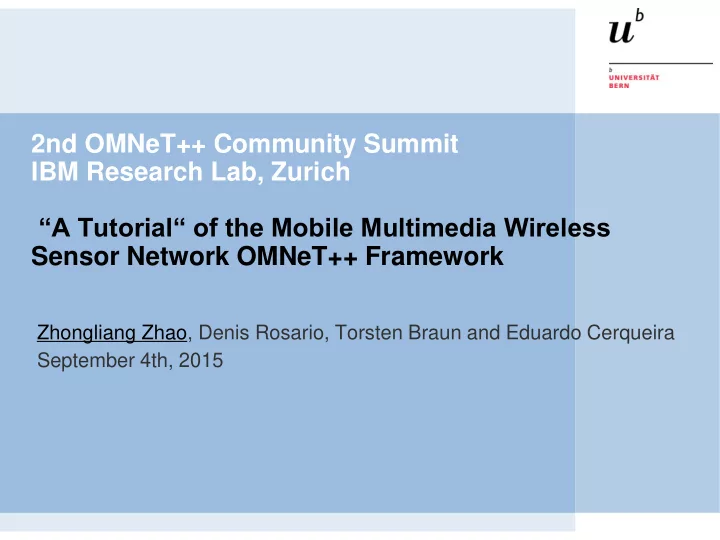

2nd OMNeT++ Community Summit IBM Research Lab, Zurich “A Tutorial“ of the Mobile Multimedia Wireless Sensor Network OMNeT++ Framework Zhongliang Zhao, Denis Rosario, Torsten Braun and Eduardo Cerqueira September 4th, 2015
Outline Introduction > M3WSN framework > Protocol evaluation > Conclusions > 2
Multimedia Wireless Sensor Networks (MWSNs) The multimedia content has the potential to enhance the > level of collected information, compared with scalar data MWSNs promise a wide range of applications, which require > audio and video transmission — Traffic collision avoidance — Environment monitoring — Video surveillance — Smart city application 3
Mobile Multimedia Wireless Sensor Networks Mobile communications are enhancing MWSN scenarios > with mobility support for objects and sensor nodes The objects that to be monitored (e.g., car, people, or > animals) are naturally mobile Mobile sensor equipped with sensor camera could be > used to explore and sense the hazardous area where rescuers can’t reach easilty or faster 4
Motivations I The development and evaluation of new protocols for > WMSNs are usually performed by network simulator Solutions involving multimedia video transmission must be > evaluated from the end- user’s perspective Video flows have different characteristics, group of picture > sizes, and coding mechanisms Multimedia transmissions/evaluations require video-related > data: Frame type > Delay and jitter requirements > Decoding errors > Inter and intra-frame dependency > 5
Motivations II Mobility traces enable the understanding of how the network > protocols and algorithms behave under different mobile cases Mobile scenarios enable complex mobility simulations, as > expected in many smart city applications OMNeT++ is a standard and general purpose network simulator > employed to study protocols in wired and wireless networks The existing OMNeT++ frameworks for WMSNs do not provide a > large set of mobility models No support of multimedia video transmission and evaluation > 6
Related Works 7
M3WSN Framework Mobile Multi-Media Wireless Sensor Networks (M3WSN) > OMNeT++ Simulation Framework Relies on Castalia architecture > Integration of functionalities of: > > WiSE-Mnet model: moving objects and object detection > WVSN model: FoV, cover set, and application criticality M3WSN provides: > — Implementation of new functions to provide mobile multimedia management — Delivering, controlling, and evauating real video sequences — Scenarios consist of fixed and mobile nodes, as well as moving object — Measurement of the impact and benefits of novel video-aware algorithms and protocols for fixed and mobile MWSNs 8
M3WSN Architecture
Multimedia Management M3WSN incorporates Evalvid, which provides video- > related information: > Received/lost frame and their types > Delay and jitter > Decoding errors > Inter and intra-frame dependency Video-related information enables the creation of new > assessment and optimization solutions for static and mobile MWSN applications M3WSN enables the definition of energy consumption > values for retrieving each frame 10
Video Trace Transmission 11
Quality of Experience Support Multimedia transmission should be evaluated from the end > user’s perspective Quality-of-Experience evaluation approaches: > > Objective > Peak Signal to Noise Ratio (PSNR) > Structural Similarity (SSIM) > Video Quality Metric (VQM) > Subjective > Mean Option Score (MOS) 12
Mobility Support M3WSN relies on BonnMotion framework (at the mobility > manager) to fully various mobility models BonnMotion provides several mobility models > > Random Walk, Random Waypoint, etc Enables users to configure the energy consumption for a > node when it is moving within a certain area 13
Protocol Evaluation Experiment Scenario > > Intrusion detection with multi-tier MWSNs > As soon as the low-tier scalar sensors detect the intruder, it wakes up/trigger the high-tier camera sensor to send the video flows > Message transmission among camera nodes follows a QoE-aware FEC (Forward Error Correction mechanism) > QoE-aware FEC (Reed-Solomon coding) achieves robust video transmission by sending redundant packets according to their importance Wake up > In case of packet loss, the original frames can be recovered from the redundant packets 14
Scenario Parameters & Metrics Parameters > Metrics > > Objective QoE evaluation: SSIM and VQM > Subjective evaluation: network overhead and transmitted frame 15
Objective Results: SSIM 16
Objective Results: VQM 17
Subjective Results: Overhead 18
Subjective Results: Transmitted Video Frame 19
Conclusion Mobile Multi-Media Wirless Sensor Networks (M3WSN) > OMNeT++ Simulation Framework Supports real video sequence transmission > Provides key video-related information, which can be used for > creating new assessment and optimization solutiosn for MWSNs Provides QoE evaluation, which is only possible through the > transmission of real video sequence Supports several mobility traces to enable the understanding of > how protocols/algorithms behave under different mobile situations http://cds.unibe.ch/research/M3WSN/ > 20
Thanks for Your Attention. zhao@inf.unibe.ch > http://cds.unibe.ch > 21
Recommend
More recommend